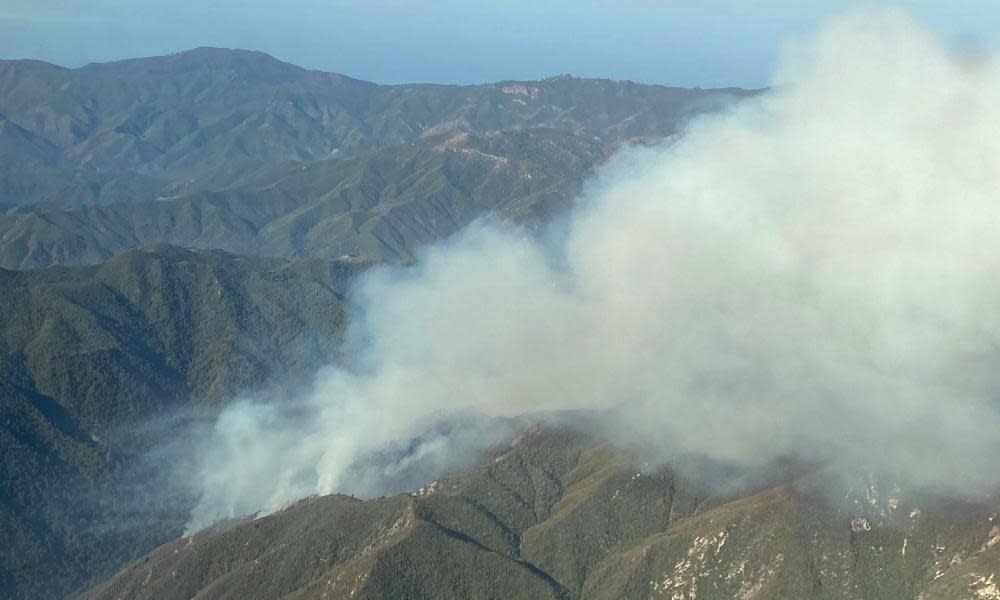Big Sur fire: hundreds of firefighters battle blaze raging in California

Firefighters are battling to contain a wildfire that erupted near Big Sur last week, as the flames continue to engulf the dry California landscape and threaten historical sites, cabins and ranches.
The fire is one of dozens of wildfires burning in hot, dry conditions across the US west, including in Arizona and New Mexico.
In Monterey county, the so-called Willow fire has burned more than 2,800 acres since it broke out on Thursday evening. More than 500 firefighters face the difficult task of trying to contain the large forest fire in the rugged coastal mountains south of Big Sur. The blaze forced the evacuation of a Buddhist monastery and nearby campground.
The area is also home to endangered species and contains cultural sites that could be at risk if the fire continues to grow, and the Los Padres national forest resource advisers have brought in biologists, botanists and Chumash tribal members to aid in protecting sensitive areas.
Related: What tree rings reveal about America’s megadrought – a visual guide
“We have to take our time accessing these areas because we can’t get the equipment in there,” said Amanda Munsey, a public information officer with California interagency incident management team 11. “Weather is also a big factor,” she adds, “and it has been very hot for a number of days – and very dry.”
Hundreds have been ordered to evacuate the mountainous area, including most of those at the Tassajara Mountain Zen Center, a historic Zen Buddhist monastery. Some monks who are part of a trained fire crew stayed behind to assist in the firefight.
There's a new update on https://t.co/kt3Dabyelq. We are deeply grateful for the 300+ firefighters who are working to keep the #WillowFire at bay as shown in this short video taken from the parking lot. #Tassajara pic.twitter.com/IDDmvGLYWJ
— San Francisco Zen Center (@sfzc) June 20, 2021
“The ZMC fire crew will remain in order to run ‘Dharma Rain’ [Tassajara’s sprinkler system] and to prepare the monastery in case the fire reaches the valley,” the center posted on its website on Sunday.
“Tassajara has been working on special fire prep projects during the pandemic shutdown and the fire crew has been in place and training for several months. Our water supplies are good and we are well prepared for this situation.”
The cause of the fire is still under investigation.
The latest wildfire comes as the American west is gripped by a historic drought, and as officials predict another record-breaking fire season. A heatwave has baked the region, intensifying drought conditions and ignition risks much earlier in the year than normal. Already this year, 33 large fires have burned more than 372,000 acres across 10 states, according to the National Interagency Fire Center.
#WillowFire
Smoke column due to afternoon winds & dry vegetation caused fire to grow in intensity. Dynamic situation requires constant monitoring. Firefighters are attacking w/fixed wing & helicopters. Crews are constructing lines as prepare for fire approach. Expect more smoke. pic.twitter.com/aLN7SYFFZs— Los Padres NF (@LosPadresNF) June 20, 2021
“Right now, in June, the dryness and the fuel conditions – it is what we would expect in August,” says Munsey. “It is alarming but it is beyond our control. So we have prepared as best as we can.”
There’s hope that cooler weather, expected with higher humidity across the Bay Area in the coming days, will help slow the flames, but there are concerns that winds along the ridges will continue to drive the fire and complicate containment efforts. But with so many fires already burning across the west, resources have been strained.
In Arizona, a blaze named the Backbone fire that has burned more than 32,750 acres after igniting last Wednesday from a lightning strike is also at 0% containment. Temperatures there have exceeded 100F and thousands of residents have been evacuated north-east of Phoenix, in the communities of Strawberry and Pine.
“There are major fires around Arizona and Utah – all over the western United States,” Munsey says. “That becomes problematic when trying to get resources to whatever fire you are on because they are already stretched so thin.”
Meanwhile, the mountainous city of Flagstaff was shrouded in smoke by another fire, dubbed the Rafael fire, on Monday. If the fire continues its north-eastern push, hundreds of people in the college city, which lies about two hours north of Phoenix, could be affected, officials say. The national forest surrounding Flagstaff announced a full closure set to begin later this week – the first time that has happened since 2006.
It’s already been a tough fire season for Arizona, which has seen multiple blazes spark this summer. On Monday, two national forests in northern Arizona made rare announcements that they would close completely to visitors starting later this week, because of concerns they won’t have enough resources to respond to any future wildfires.
In New Mexico, lightning-sparked blazes have been scorching the southern part of the state, where a large portion of the Gila wilderness remains closed, and fire officials are closely watching the Gila Cliff Dwellings national monument.
Firefighters in Oregon were focused on two wildfires, one burning near the state’s highest peak and another in the southern part of the state that was threatening 125 structures.
And in Utah, several wildfires were burning in bone-dry conditions. The largest near the small town of Enterprise in southern Utah forced evacuations over the weekend.
The Associated Press contributed reporting

